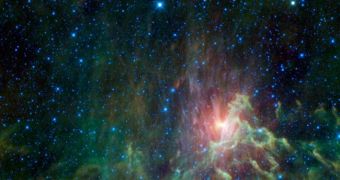Just two weeks after celebrating its one-year anniversary in orbit, a NASA telescope has just beamed back some amazing images of massive cosmic dust and hydrogen gas clouds called nebulae. A little bit of processing done by experts at the space agency really brings out the details in these structures.
Nebulae are the remains of massive stars that went supernova, and shed the outer layers of their atmospheres before they did so. Because of the leftover radiation, they appear very luminous and eerie.
They are also stellar nurseries, hot spots for the formation of new stars. The cosmic fireballs are produced when large enough gas clouds collapse under their own weight, and ignite as they do so.
The thermonuclear reaction that ensues keeps the protostar ablaze, and the structure then begins to accrete even more mass from the surrounding clouds. Large nebulae usually contain tens to hundreds of forming stars.
Due to its nature, the NASA Wide-field Infrared Survey Explorer (WISE) telescope is capable of penetrating the massive dust shells surrounding the young stars, imaging them as they develop.
Observatories operating in visible wavelengths cannot pierce to the core of nebulae, due to their dust envelopes. But WISE is especially equipped for such studies, conducing investigations in four different infrared wavelength ranges.
The telescope was launched on December 14, 2009, from Space Launch Complex 2W at the Vandenberg Air Force Base, in California. The telescope was carried to orbit by the Delta II 7320-10 launch vehicle.
One of the most impressive photos the instrument sent back depicts the Flaming Star Nebula, which lies some 1,500 light-years away from Earth, in the constellation Auriga, Space reports.
Right at the core of the space structure lies the star AE Aurigae, which looks like it's ablaze as seen from our vantage point. One of the most interesting things about it is that it's a runaway star.
This means that it was expelled from the nebula in which it formed, and sent to wonder through space at high speeds. Astronomers believe that the object most likely originated in the Trapezium Cluster.
The formation is located in the constellation Orion. AE Aurigae may have been ejected from its home some 2.5 million years ago, following a collision with a binary star system.
Now the star has found a new home in this nebula, where blue and cyan indicate the presence of newly-born stars. Green indicates glowing hydrogen gas, whereas red shows the location of heated dust.

 14 DAY TRIAL //
14 DAY TRIAL //